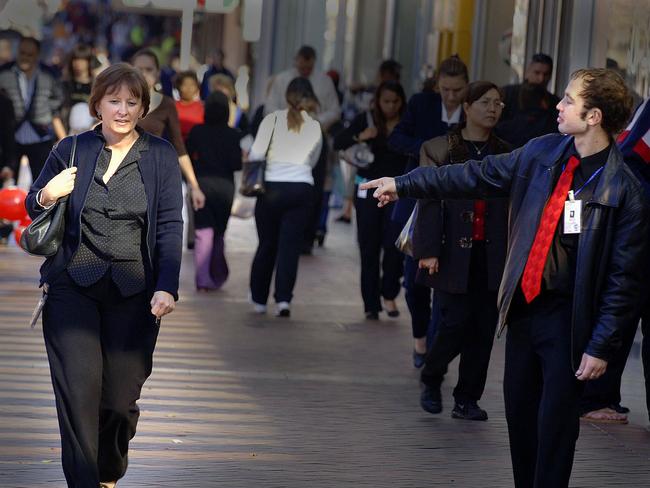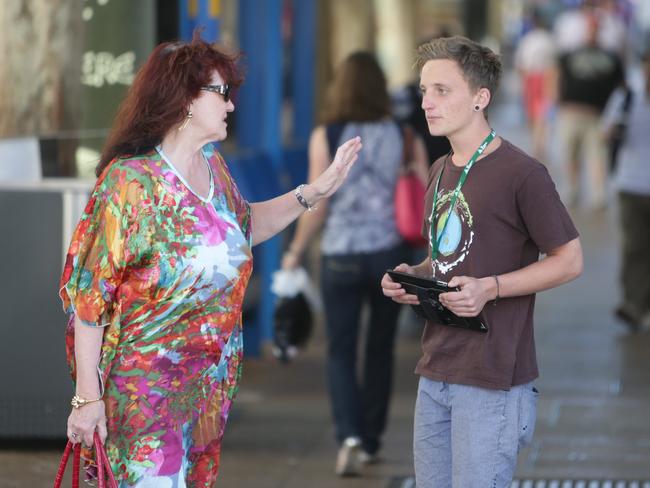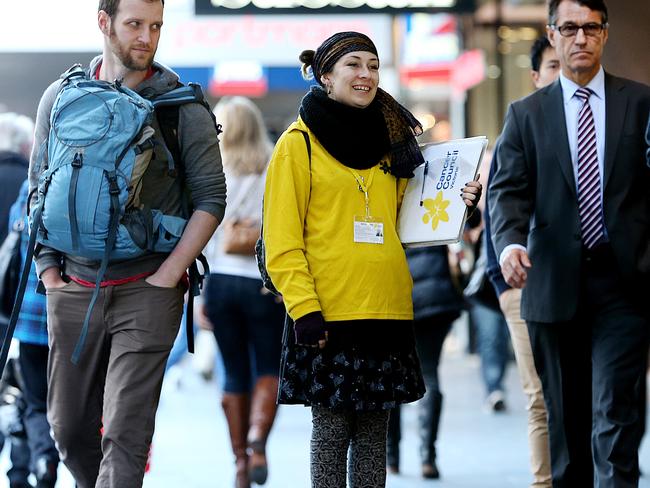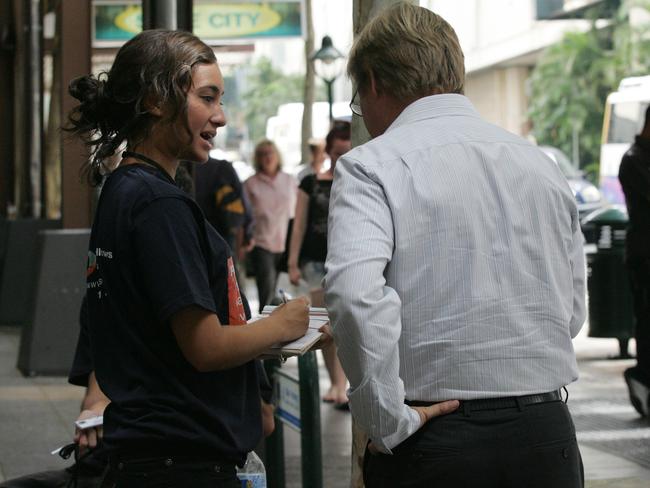Chuggers: The truth behind the clipboard people
WE LOVE to hate charity muggers. They’re pushy, rude, and they really want to shake your hand. But does the money actually go where they say it does?

AUSSIES love to hate charity muggers.
They’re pushy. They can be rude. And they really want to shake your hand. But should we stop being so hard on them?
In the lead-up to Christmas, shoppers all over Australia can expect to see the notorious ‘chuggers’ out in force.
While Melbourne and Brisbane City Councils have taken steps to crack down on the practice in recent years — Melbourne Lord Mayor Robert Doyle even said he’d like to see them gone altogether — Sydney under Lord Mayor Clover Moore has taken a softer approach.
City of Sydney says it has no plans to impose greater restrictions on charity collectors, but Liberal councillor Edward Mandla — who has his sights set on the top job in 2016 — has other ideas.


“Apart from being mugged, there is little worse than being ‘chugged’ by an overenthusiastic, 50 per cent commission-only, backpacking charity collector that makes you shake their greasy hand on a hot day,” he said. “I think the general public would give out a big cheer if they were gone altogether.”
Cr Mandla says the City already has a specific footpath policy that prevents this kind of hard selling, but “there’s no money in enforcing it”. “The worn-out City of Sydney administration has an unofficial policy to ignore the official policy. The elections can’t come soon enough,” he said.
For their part, the charities argue they’re a necessary evil — a minor inconvenience is a small price to pay for the overall benefit.
As much as they might annoy people, the reality is they work. Of the 230,000 donors who signed up for regular giving in 2012, 90 per cent were acquired through face-to-face activity, according to peak body Fundraising Institute Australia.
Rob Edwards, chief executive of FIA, said while it was “probably fair to say” that some street fundraisers become “a little more enthusiastic than others” to get attention, the charities would lose an enormous amount of income without them.

“I think you’ve got to be careful with some of these statements. It can be a populist thing to say to garner support for political reasons,” he said. “I’m just like the average citizen — even I might cross the road when I see them. But it is the most effective form of fundraising.”
Donations via face-to-face sign-ups are worth hundreds of millions of dollars a year to the sector, which collectively works to “feed the hungry, protect children, prevent violence and improve our environment”, says FIA.
According to Pareto Fundraising’s benchmarking study from 2012, regular donations rose by around $30 million year-on-year to $245 million in 2012.
NAB’s most recent Charitable Giving Index showed the average annual donation is $85 per person, taking into account the millions of people who do not donate. The average donor hands over $315 annually – an $11 increase on the last year, according to NAB.
Crucially for the charities, face-to-face allows them to reach a younger demographic. Almost 60 per cent of those who sign up for regular donations via face-to-face are under 40, and on average they stay for three years or more. “It’s a way of engaging with a whole new generation of people,” said Mr Edwards.


Earlier this year, the Herald Sun revealed Brisbane-based Cornucopia Consulting offering free flights to bring backpackers over from the UK, US and Europe to work as street charity collectors. Cornucopia deploys fundraisers on behalf of the Red Cross, Amnesty International, Medecins Sans Frontieres and The Fred Hollows Foundation.
While it may cause controversy, the FIA argues that using third-party fundraisers allows charities to focus on what they do best and ensure the money raised is used as effectively as possible.
Angela Brooks, director of McNair Ingenuity Research, which for more than 20 years has run an annual survey tracking awareness and support of various charities, says it’s a “never-ending problem” for the sector.
With most people giving to 3.3 charities on average, and nearly half of those already giving to the Red Cross or Salvation Army, that means there are 3000-odd charities all fighting to take one of the remaining spots.


“I can fully see why organisations will try whatever they think will work,” she said. The problem is that consumers consistently rank face-to-face near the bottom when asked how they prefer to donate.
“It may well be true that 90 per cent who give an ongoing donation come via face-to-face, but that doesn’t mean 90 per cent of people want to give an ongoing donation when accosted in the street,” she said.
But ultimately it’s about awareness. For charities that can’t afford expensive marketing campaigns, it’s a case of “there’s no such thing as bad publicity”, according to Ms McNair.
“I don’t personally like being accosted on the street, but what they are doing is increasing awareness. Getting your awareness up is key to getting your donors up.”




